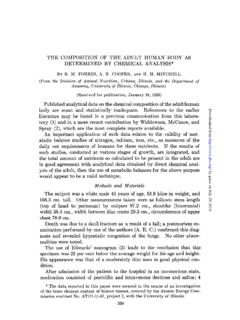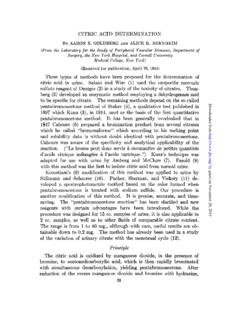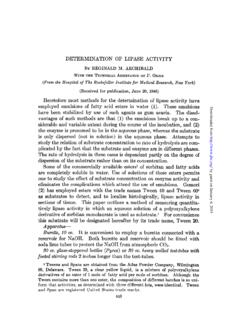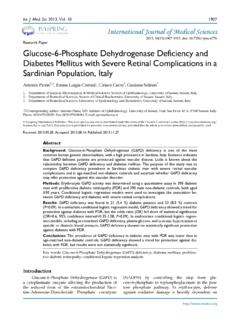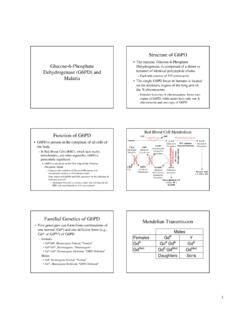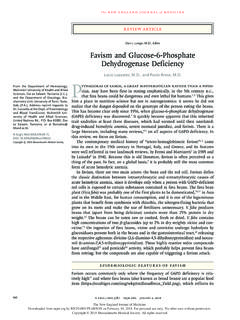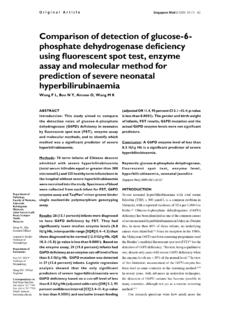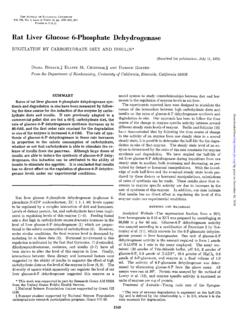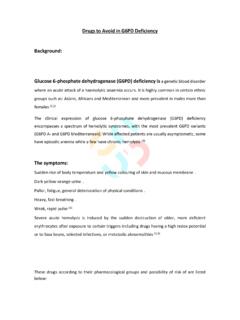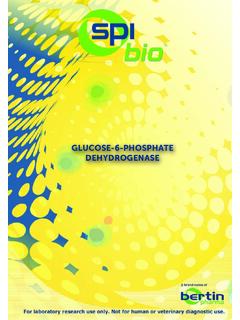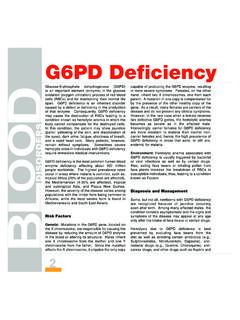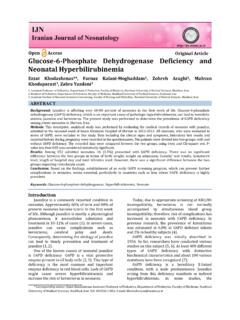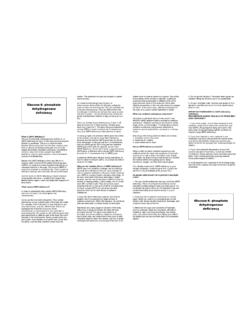Transcription of Glucose-6-phosphate Dehydrogenase
1 THE <JOURNAL OF ~CAI. CHEMISTRY Vol. 251. No. 8. Issue of April 25. pp. X5, ;. 1976 Printed in Glucose-6-phosphate Dehydrogenase PURIFICATION AND PARTIAL CHARACTERIZATION (Received for publication, September 10, 1975) MOHAMMED I. KANJI, MYRON L. TOEWS, AND W. ROBERT CARPER* From the Department of Chemistry, Wichita State University, Wichita, Kansas 67208 Glucose-6-phosphate Dehydrogenase has been purified lOOO-fold from pig liver. This enzyme exists as an active dimer of molecular weight 133,000 and an inactive monomer of molecular weight 67,500. The pH of maximum activity is and the ionic strength maximum is to M.
2 Glucose-6-phosphate Dehydrogenase is highly specific for NADP+ and glucose B- phosphate . Apparent K, values of pM and WM were obtained for glucose 6- phosphate and NADP+. This enzyme is located almost entirely within the soluble portion of the cellular cytoplasm. The pentose phosphate shunt occurs widely in living cells where one of its main functions is to provide the NADPH necessary for the synthesis of fatty acids and other specific reductions. The biosynthesis of fatty acids is related to the oxidative part of the shunt where the enzymes glucose -6-phos- phate Dehydrogenase and 6-phosphogluconate Dehydrogenase produce the necessary NADPH.
3 The above facts along with the strategic position of Glucose-6-phosphate Dehydrogenase (D- Glucose-6-phosphate :NADP oxidoreductase EC ) at a metabolic branch point, suggest that the Glucose-6-phosphate Dehydrogenase reaction is an important site of metabolic control. This view is supported by several investigators who have shown variations in enzyme activity as a function of hormone and nutritional levels (1, 2), enzyme quaternary structure, and various metabolites including ATP, ADP(3), spermidine, and palmitoyllCoA(4). It is our purpose to study Glucose-6-phosphate dehydrogen- ase from pig liver and to determine the effect that various metabolites have on its kinetic properties.
4 glucose -6-phos- phate Dehydrogenase has been previously isolated from micro- organisms, erythrocytes, and various mammalian tissues (5-17). In this work, we report the isolation, purification, and partial characterization of this enzyme from pig liver. The purification scheme includes homogenization. acid denatura- tion, Triton X-100 treatment, Sephadex gel filtration, and ion exchange chromatography with DEAE-cellulose. Characteriza- tion studies include molecular weight determination, pH, and ionic strength effects, a subcellular fractionation, and prelimi- nary kinetics. MATERIALS AND METHODS Chemicals- glucose & phosphate , glucose oxidase, NADPH, NADP+, bovine serum albumin, catalase, and lactate Dehydrogenase were purchased from Sigma Chemical Co.
5 Blue dextran, yellow dextran, and Sephadex were purchased from Pharmacia Fine Chemi- *To whom all communications regarding this paper should be addressed. cals. DEAE-cellulose was obtained from Bio-Rad Laboratories. Other reagent grade chemicals were purchased either from the California Biochemical Co. or Sigma Chemical Co. Experimental Procedures- Glucose-6-phosphate Dehydrogenase was routinely assayed spectrophotometrically. The usual assay mix- ture contained ml of M NaOH/glycine buffer, pH , ml of 30 mM M&l,, ml of rnM NADP+, ml of 30 mM glucose , and ml of enzyme. The reaction was followed at 340 nm using a Gilford DU spectrophotometer equipped with a Texas Instruments recorder and connected to a constant temperature bath set at 30 +.
6 The formation of NADPH produced a linear increase in absorbance readings for periods of 3 min or longer after the addition of glucose to a l-cm cuvette. All activities were recorded as change in absorbance per min and later converted to concentrations per min using an extinction coefficient of 1 cm . One unit of activity is defined as the amount of enzyme required to produce 1 wmol of NADPH/min at 30 . Protein concentration was determined either by the method of Warburg and Christian (18) or by the microbiuret method of Goa (19). Localization of Enzymes-For the determination of the subcellular localization of the enzyme, freshly slaughtered pig liver was homoge- nized and fractionated according to a modified method of Schneider and Hogeboom(20).
7 The liver was first cut into small pieces and 2 g were suspended in 14 ml of M sucrose containing M sodium phosphate buffer, pH The cells were homogenized in a Potter- Elvehjem type glass homogenizer. The operation was repeated four times such that 8 g of liver were homogenized in a total volume of approximately 60 ml. The homogenate was centrifuged at 1,000 x g for 20 min and the precipitate containing nuclei, blood, and ce!lular debris was discarded. The supernatant fraction was then centrifuged for 10 min at 9,000 x g. The resulting pellet was washed twice in the same medium and centrifuged twice at the same speed.
8 The washed pellet was designated as the mitochondrial fraction. The 9,000 x R superna- tant fraction was further centrifuged at 20,000 x a for 20 min to remove any unwanted mitochondria still remaining. The supernatant portion of this treatment was centrifuged at 100,000 x R for 40 min. The pellet collected at this stage was washed once in the same medium and was presumed to contain the microsomal fraction. The liquid remaining after 100,000 x B centrifugation was designated as the soluble supernatant fraction. The soluble supernatant fraction was treated with ammonium sulfate at 55% saturation and the precipitate redis- solved in 8 ml of M sodium phosphate buffer, pH The washed mitochondrial and microsomal fractions were finally disrupted by freezing and thawing four times in 5 ml of M sodium phosphate buffer containing sodium cholate.
9 The disrupted mitochondrial 2255 by guest on December 11, 2020 from 2256 glucose -6-P Dehydrogenase fraction was finally-centrifuged at 40,000 x g for 20 min and the four purification steps listed in Table I. The enzyme loses almost all activity on a Sephadex column unless the column is equilibrated with lo- M NADP+. Finally, the enzyme is stable and retains the original activity for a period of several weeks at 4 after DEAE-cellulose chromatography. The enzyme showed no reaction with glucose concentration levels in the range of to rnM. precipitate discarded. The microsomal fraction was centrifuged at 100,000 x g for 20 min, and the supernatant portion retained.
10 Both Glucose-6-phosphate Dehydrogenase and glucose Dehydrogenase were assayed in the clear supernatant portions of the various fractions. glucose Dehydrogenase was assayed with glucose ( mM) and NAB (50 FM) as substrates in M glycine buffer (1 mM EDTA) at pH 10, 30 . RESULTS AND DISCUSSION Purification of Enzyme-Hog liver fresh from the slaughter- house was cut into 2-cm chunks, and 15-g amounts were homogenized in a Waring Blendor for 90 s with M pH 7 phosphate buffer. The pH of the resulting solution was lowered to with 20% acetic acid, and then stored at 4 for at least 2 hours. At this point, the solution was centrifuged at 6,000 x g for 30 min at 4 and the pellet discarded.

